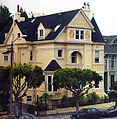Victorian architecture
From Wikipedia, the free encyclopedia
The term Victorian architecture can refer to one of a number of architectural styles predominantly employed during the Victorian era. As with the latter, the period of building that it covers may slightly overlap the actual reign, 20 June 1837 – 22 January 1901, of Queen Victoria after whom it is named.
Contents |
[edit] Varieties of Victorian architecture
- British Arts and Crafts movement
- Gothic Revival
- Italianate
- Jacobethan (the precursor to the Queen Anne style)
- Neoclassicism
- Neo-Grec
- Painted ladies
- Queen Anne
- Renaissance Revival
- Romanesque Revival (includes Richardsonian Romanesque)
- Second Empire
- Stick-Eastlake
- Industrial architecture
There are also Folk and Shingle Style Victorian Houses. Please note that the names of architectural styles (as well as their adaptations) varied between countries. Many homes combined the elements of several different styles and are not easily distinguishable as one particular style or another. In the USA, Highly decorated houses are sometimes called gingerbread houses.
Notable Victorian era cities include London, Toronto, Boston, Richmond, Saint Paul, St. Louis, Louisville, Galena, IL, Galveston, San Francisco, Chicago, Detroit, Glasgow, Sydney, Melbourne, Manchester, Kolkata, Mumbai, Pittsburgh, Philidelphia, Grand Rapids, and New Orleans.
In the USA, the South End of Boston is recognized by the National Register of Historic Places as the oldest and largest Victorian neighborhood in the country.[1][2][3] Old Louisville in Louisville, Kentucky also claims to be the nation's largest Victorian neighborhood.
Richmond, Virginia is home to several large Victorian neighborhoods, the most prominent being The Fan and Church Hill. Church Hill has the distinction of being the place where Patrick Henry gave his famous Give me liberty or give me death speech at historic Saint John's church. The Fan is best known locally as Richmond's largest and most 'European' of Richmond's neighborhoods and nationally as the largest contiguous Victorian neighborhood in the United States.[4]
The Distillery District in Toronto contains the largest and best preserved collection of Victorian-era industrial architecture in North America. Cabbagetown is the largest and most continuous Victorian residential area in North America. Other Toronto Victorian neighbourhoods include the Annex, Corktown, Parkdale, and Rosedale.
The photo album L'Architecture Americaine by Albert Levy published in 1886 is perphaps the first recognition in Europe of the new forces emerging in American architecture[5].
The Old West End neighborhood of Toledo, Ohio is recognized as having the largest collection of late Victorian and Edwardian homes in the United States , East of the Mississippi.[6]
Carroll Avenue in Los Angeles contains that city's highest concentration of Victorian homes.
- See also: Georgian architecture.
|
Victorian slums in Wetherby, West Yorkshire |
The Aston Webb building at the University of Birmingham, UK. |
The California Southern Railroad's San Diego, California passenger terminal, built in 1887. |
An example of the American Queen Anne style in Lebanon, Illinois. |
|
A Victorian house in Alameda, California |
Melbourne's world heritage Royal Exhibition Building and fountain built in 1880 |
Rialto buildings, Melbourne, built during the city's land boom of 1888 |
|
|
Banff Springs Hotel, built in 1888 |
A grand Victorian style house located on the corner of Hanbury Street and Highfield Street, Mayfield, New South Wales, Australia |
Late Victorian farmhouse near Barrie, Ontario, Canada |
Michelsen Farmstead built in 1899, is a Victorian style farmstead that is a Provincial Historic Site of Alberta located in the National Historic Site, Stirling, Alberta, Canada. |
|
The Gilbert Scott Building of University of Glasgow, as viewed from Kelvingrove Park, Glasgow. An example of the Gothic Revival style. |
The front elevation of the Glasgow City Chambers, as seen from George Square, Glasgow. |
The C. A. Belden House, a Queen Anne Victorian in the Pacific Heights section on Gough Street Between Clay and Washington Streets. The house is on the National Register of Historic Places in San Francisco. |
The Saitta House, Dyker Heights, Brooklyn, New York built in 1899 is designed in the Queen Anne Style.[7] |
|
Victorian School of Art and Science at Stroud, Gloucestershire |
[edit] References
- ^ South End Realty Group
- ^ http://en.wikipedia.org/wiki/South_End
- ^ South End Historical Society
- ^ The Fan District - Great Public Spaces | Project for Public Spaces (PPS)
- ^ "American Victorian Architecture", by Arnold Lewis and Keith Morgan. 120 photos. Dover publications, 1975
- ^ Stine, L. (2005) Historic Old West End Toledo, Ohio. Bookmasters.
- ^ “Saitta House - Report Part 1”,DykerHeightsCivicAssociation.com
- Dixon, Roger and Muthesius, Stephan. Victorian architecture. Thames & Hudson: 1978. ISBN 0-500-18163-2
- Prentice, Helaine Kaplan, Rehab Right, Ten-Speed Press. ISBN 0-89815-172-4, includes descriptions of different Victorian and early 20th Century architectural styles common in the San Francisco Bay Area, particularly Oakland, and detailed instructions for repair and restoration of details common to older house styles.
[edit] See also
[edit] External links
- History and Style of Victorian Architecture and Hardware
- Manchester, a Victorian City
- Photographs of Victorian Homes in Hamilton, Ontario Canada
- Victorian era architecture in San Francisco, California
- Victorian era architecture and history in Buffalo, New York
- Architectural influences on Victorian style





















